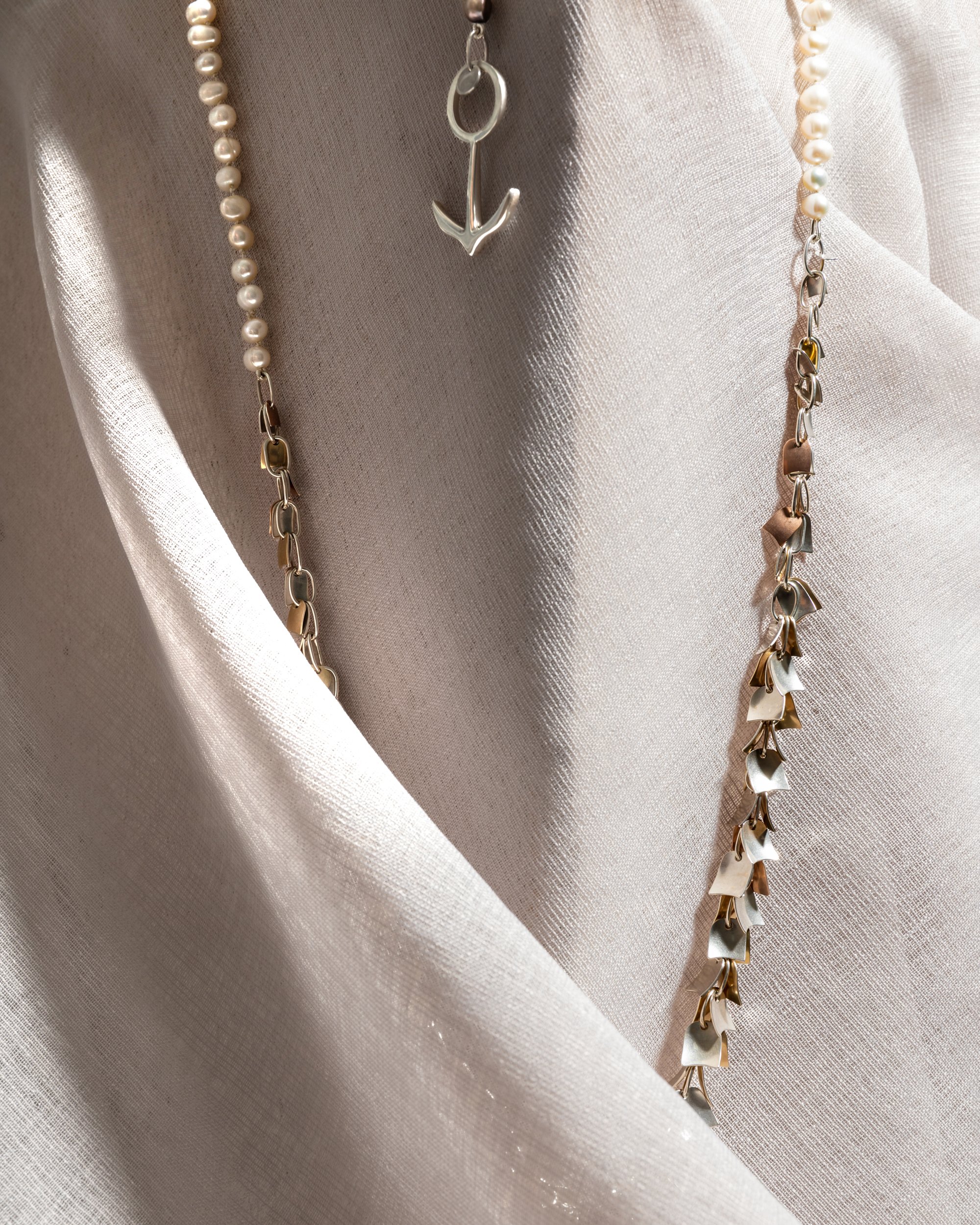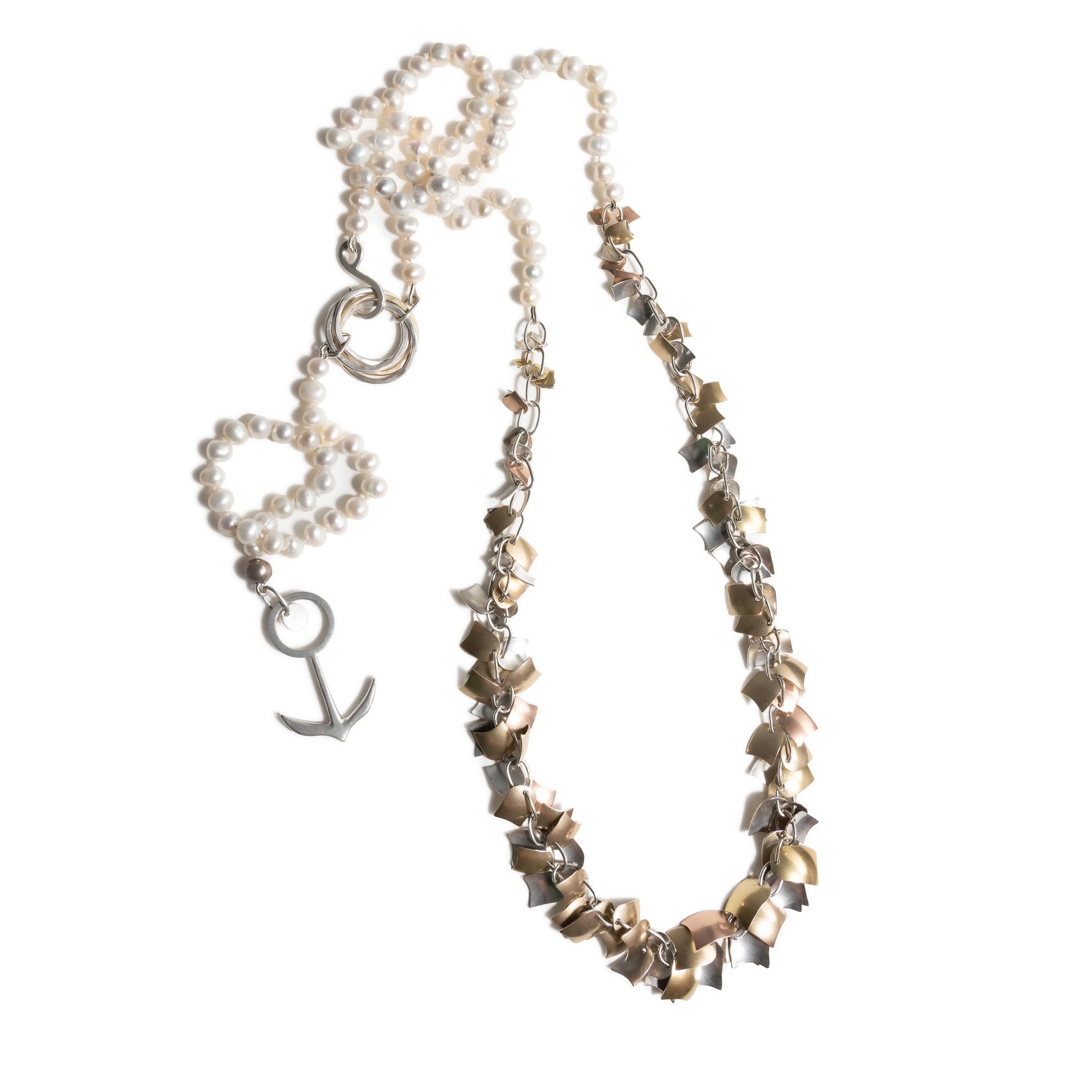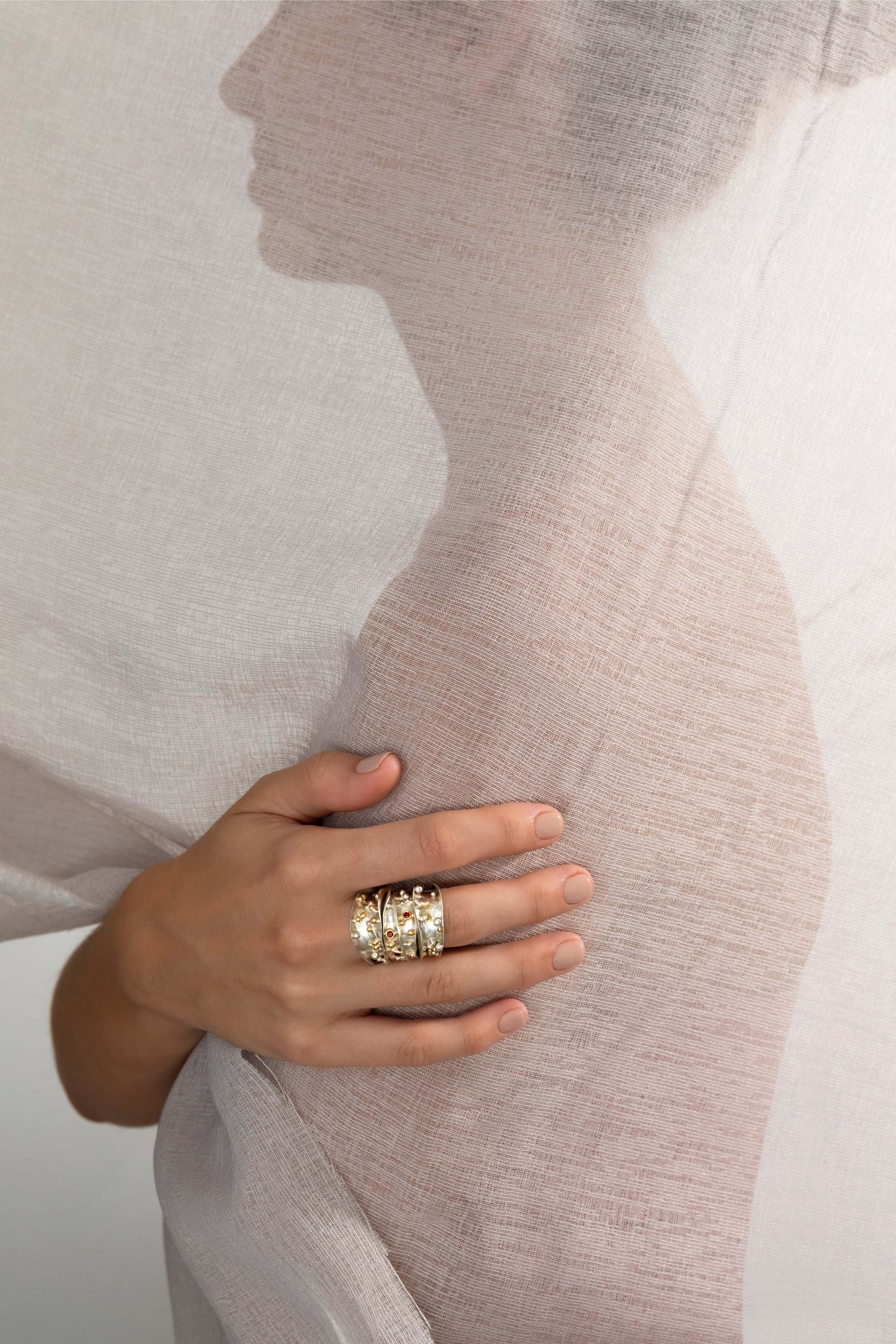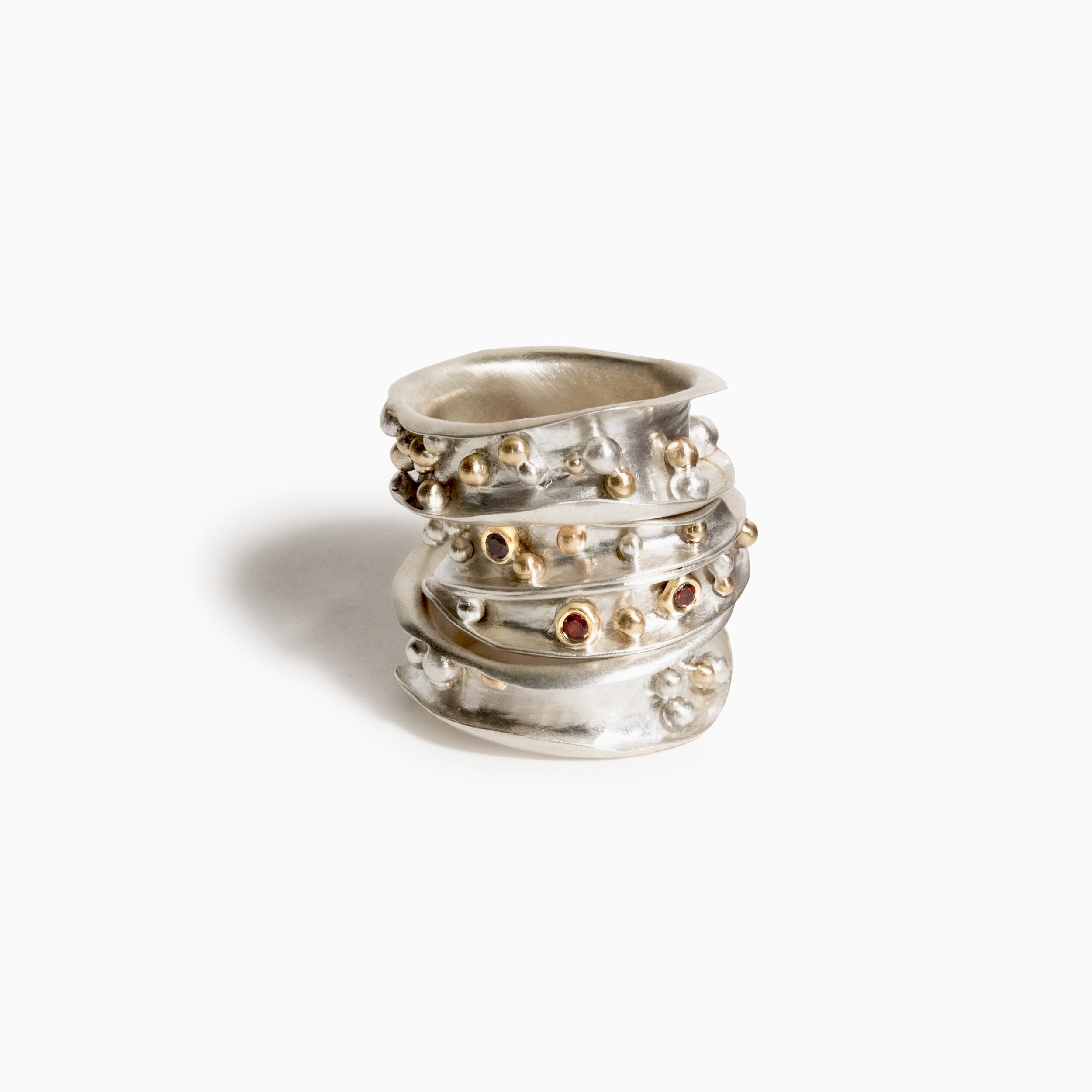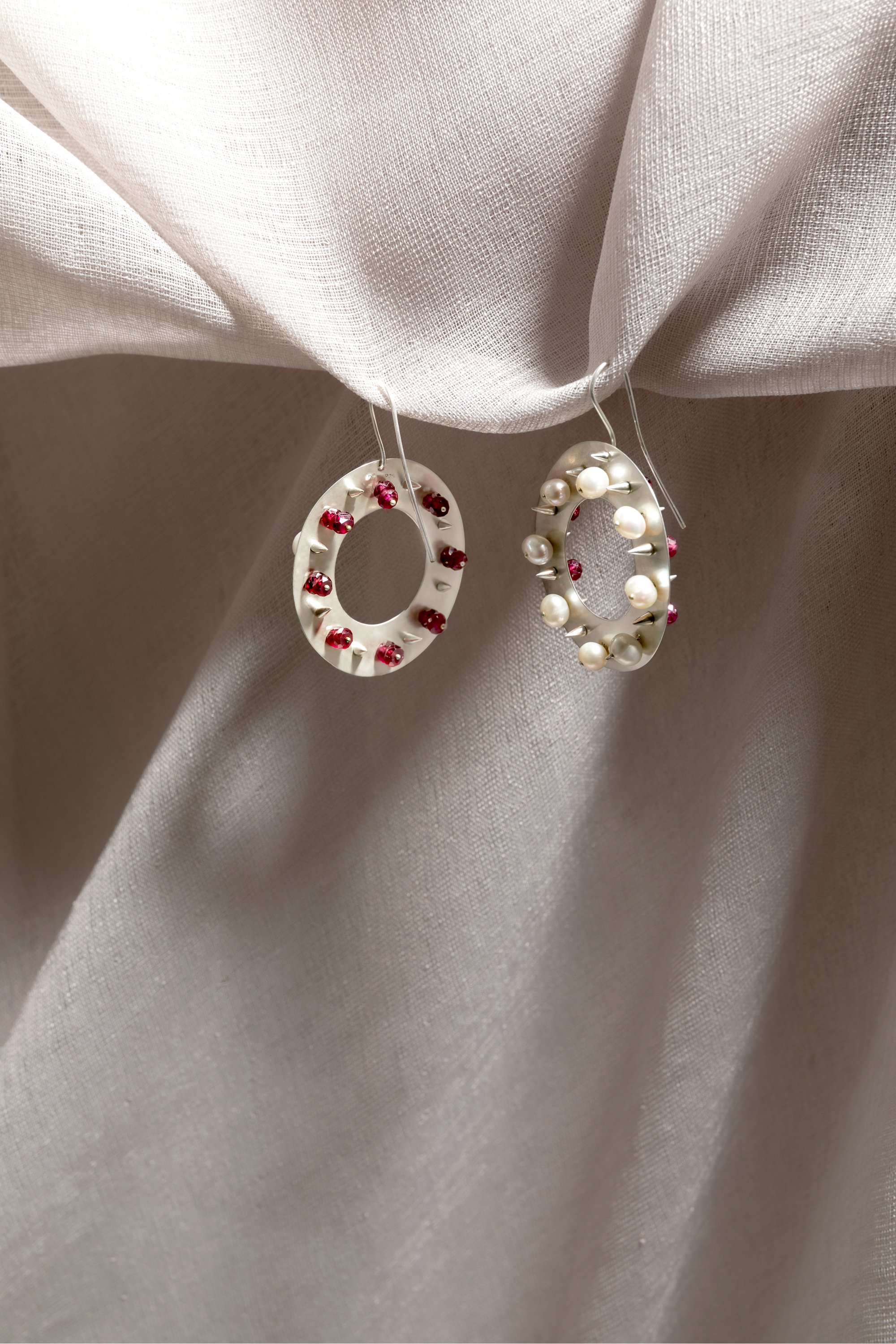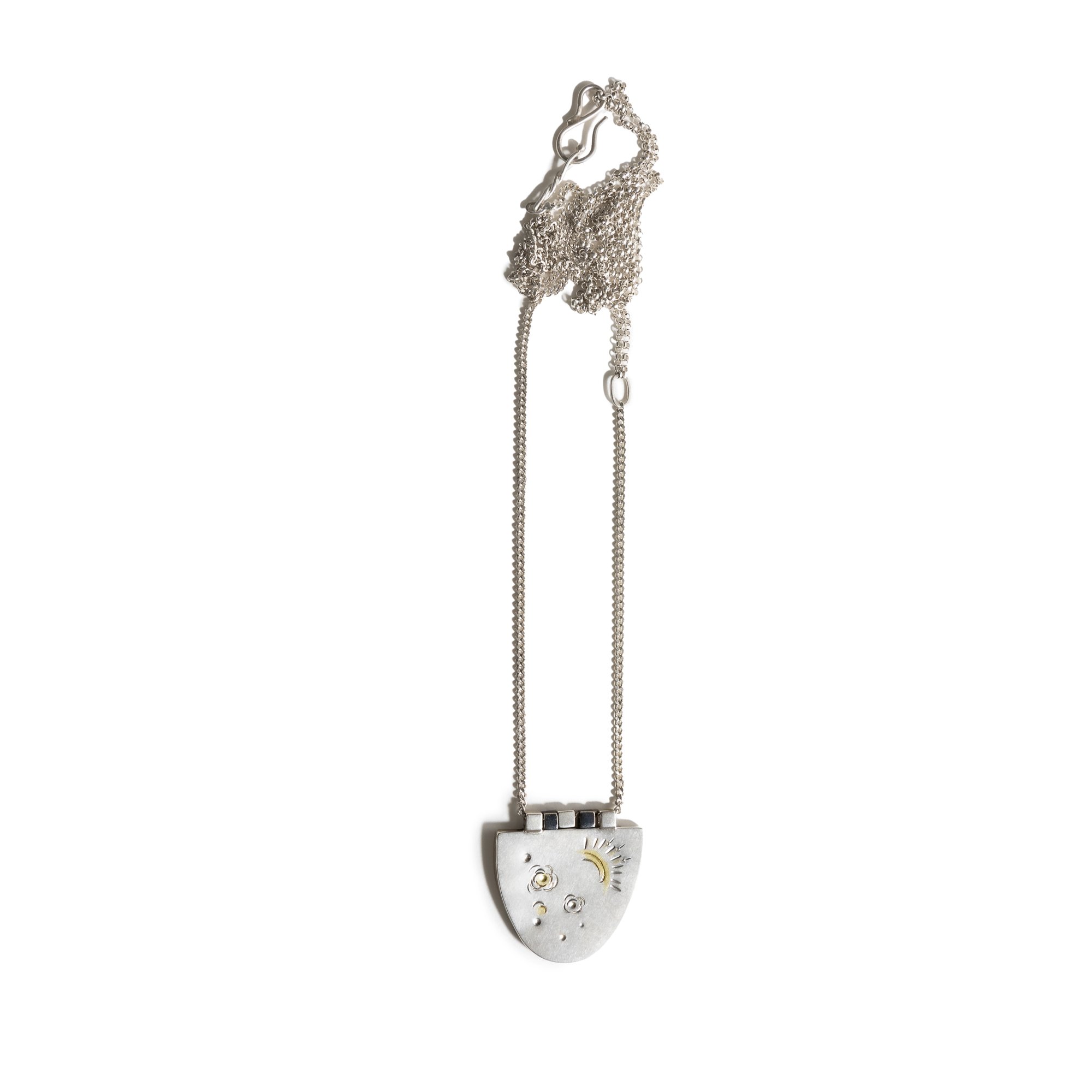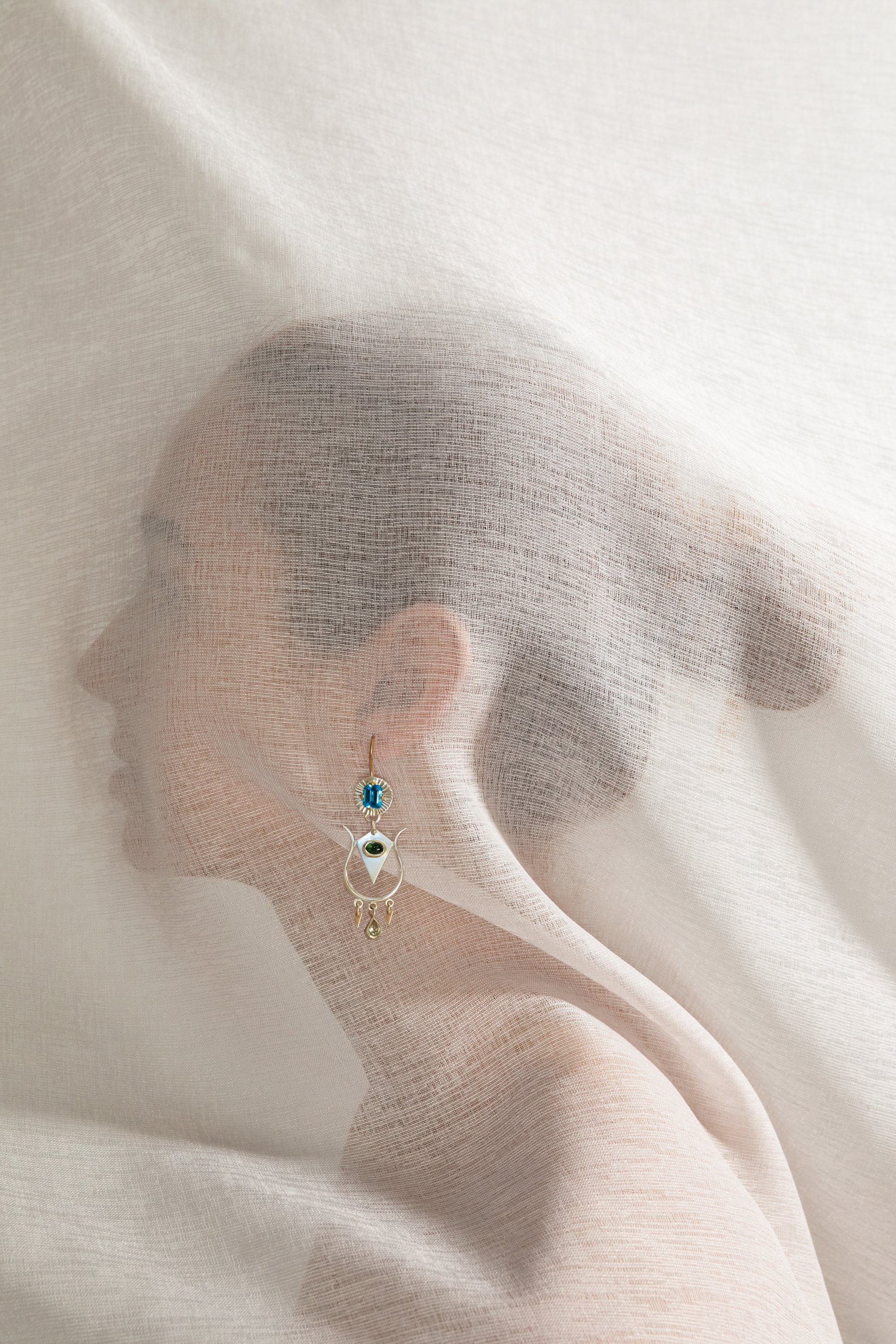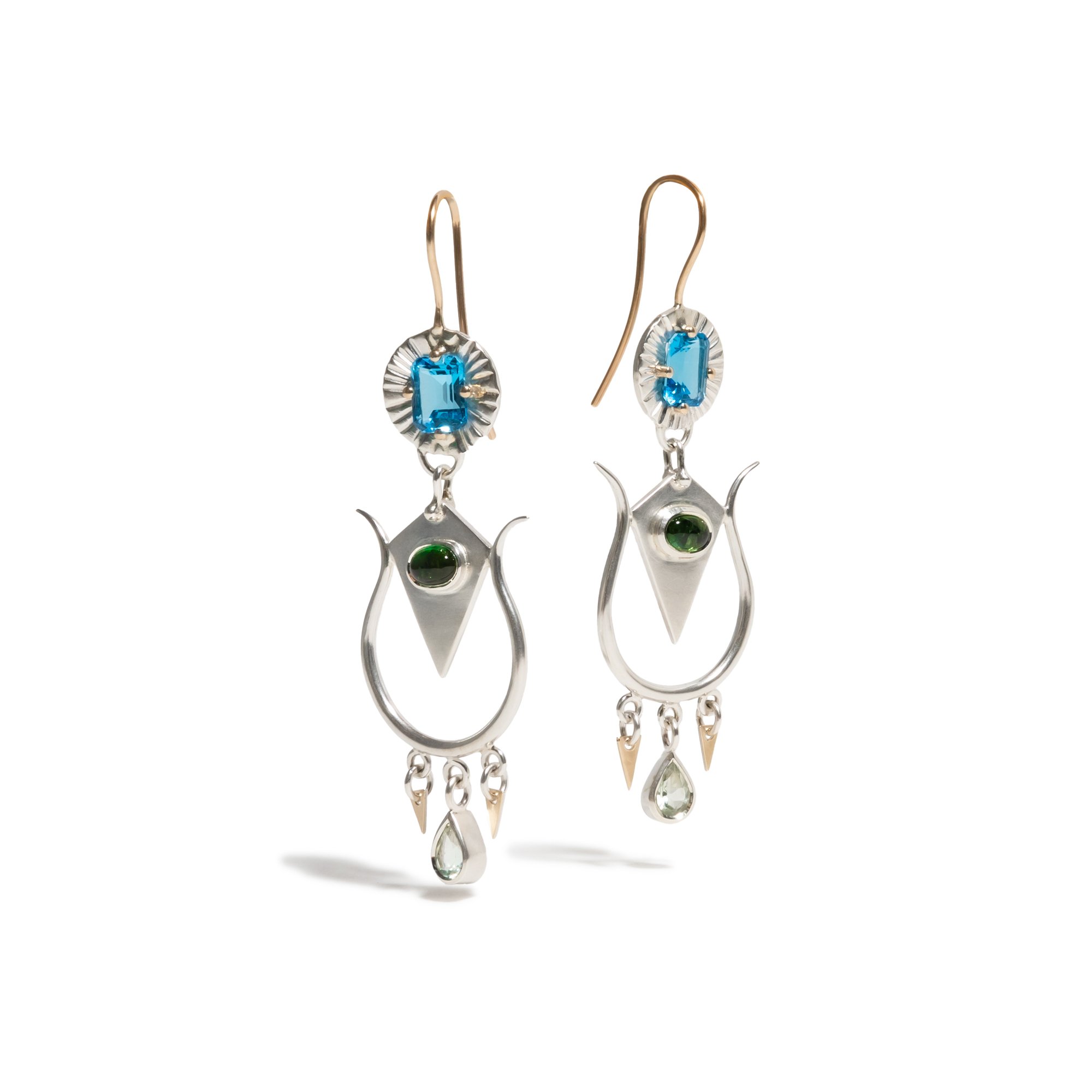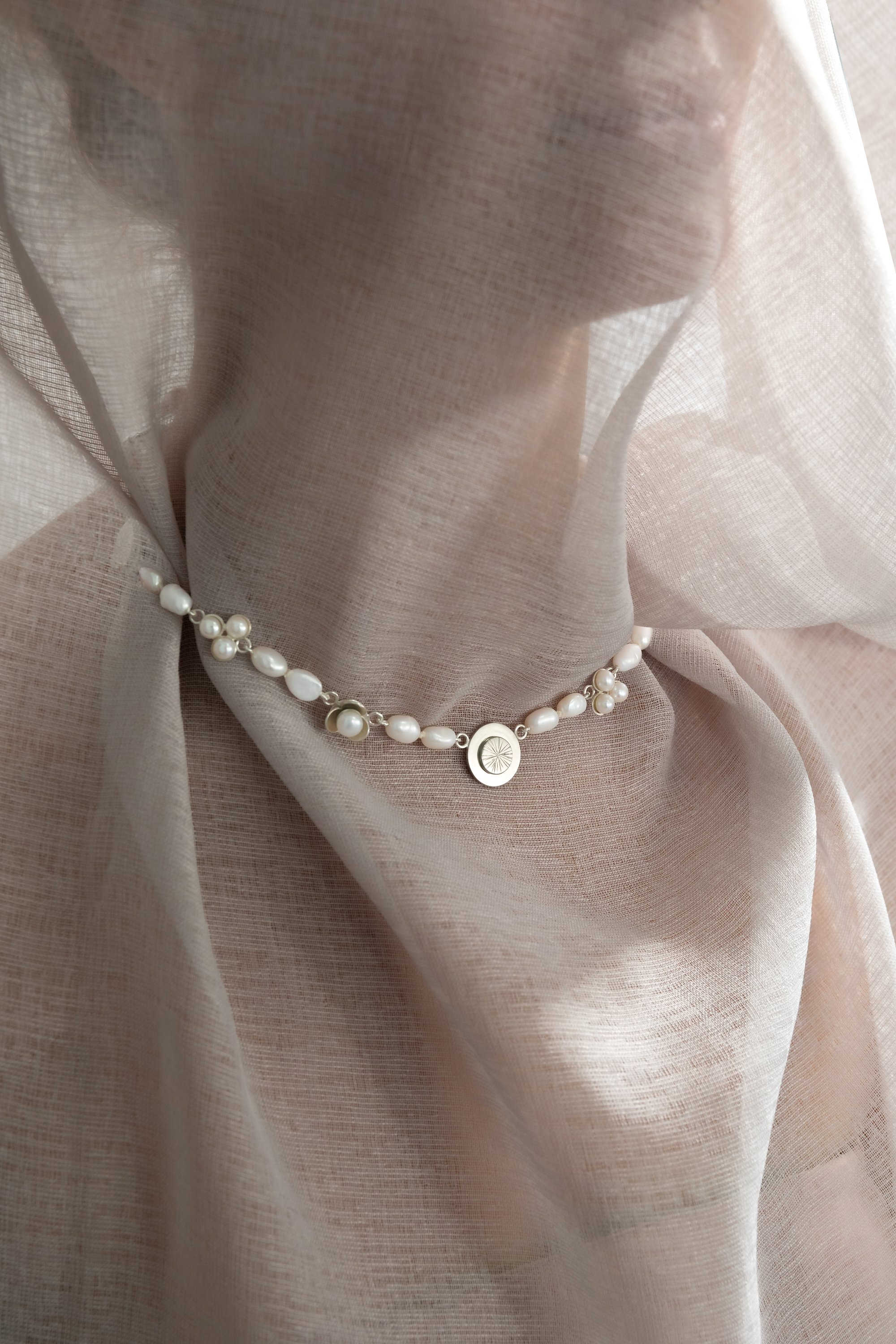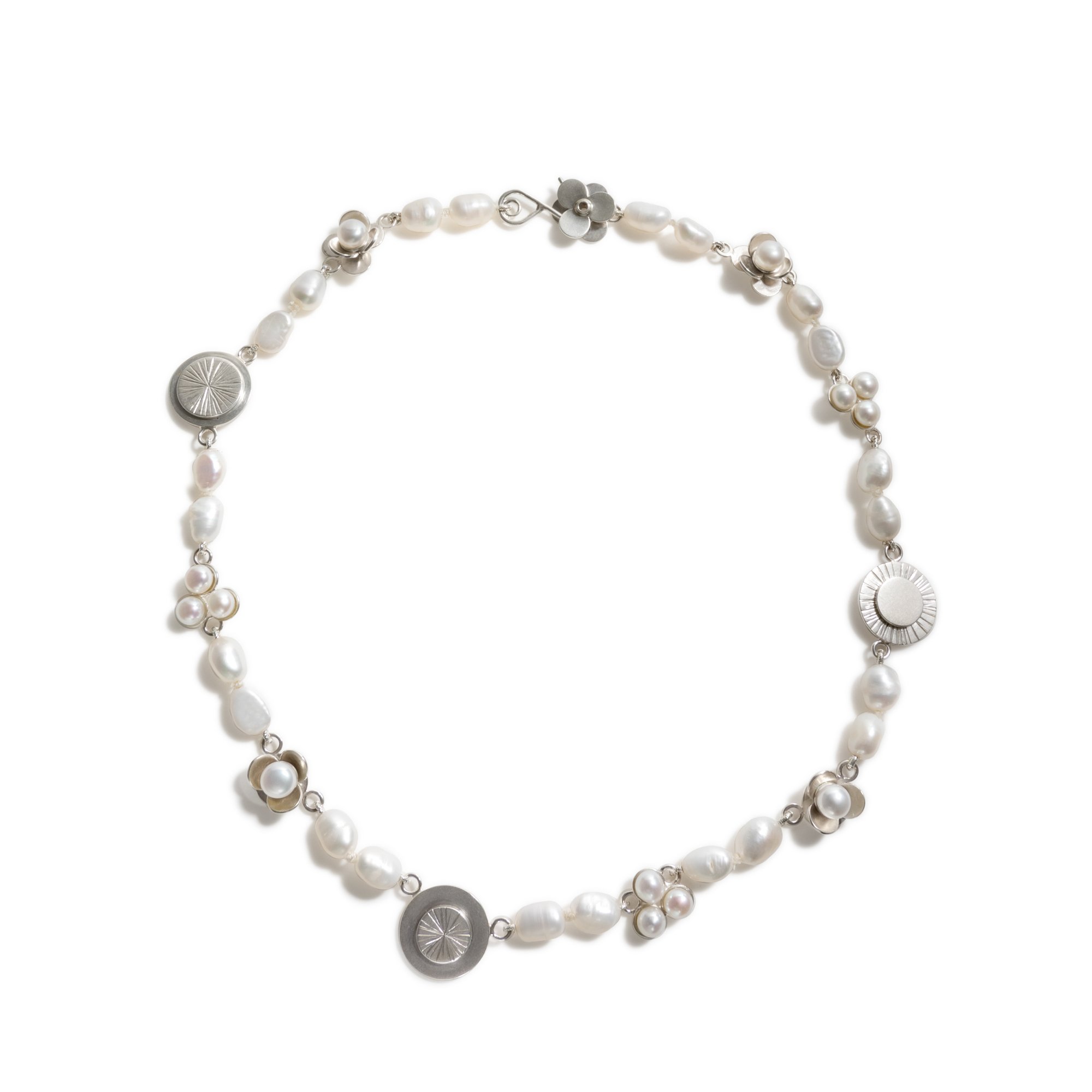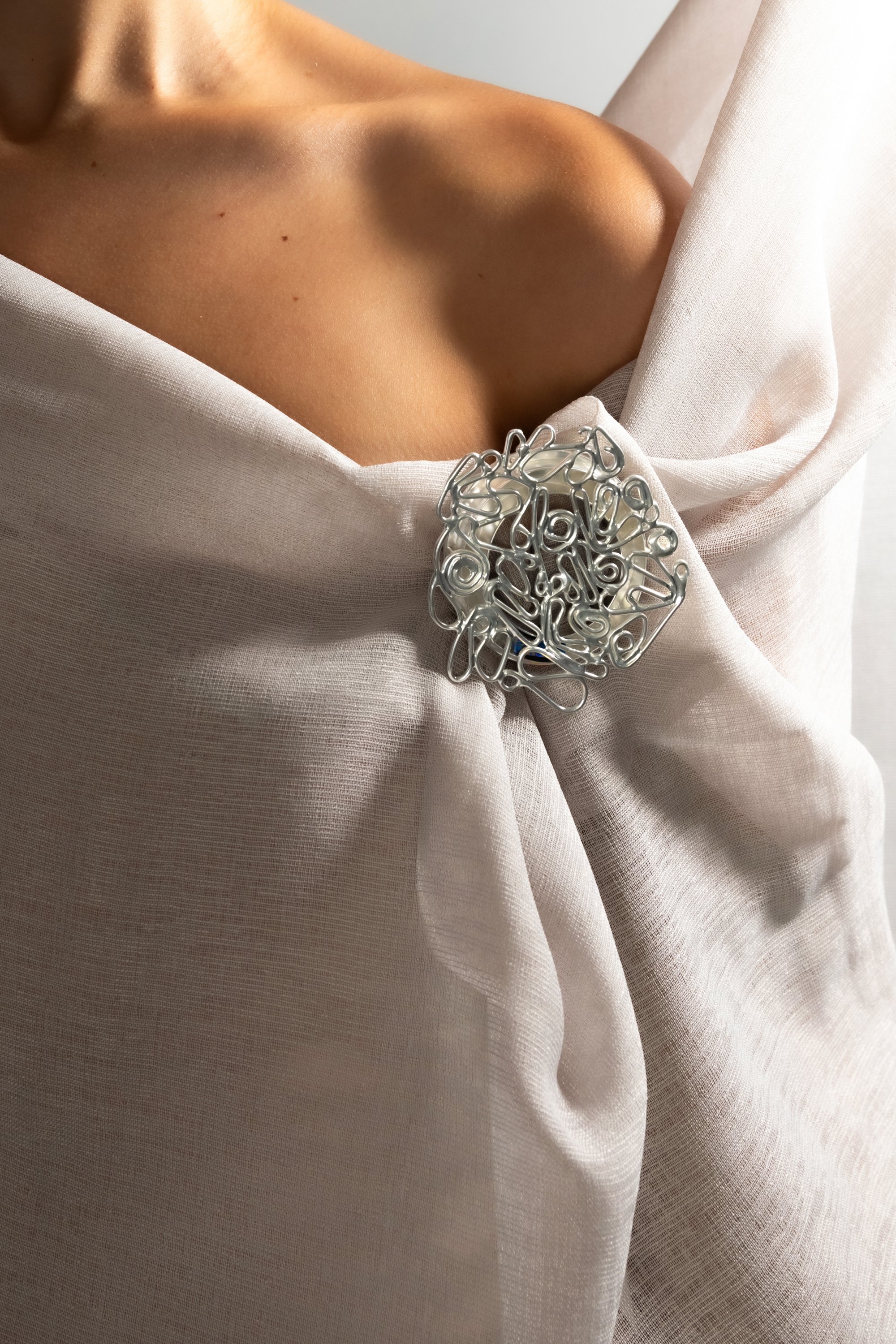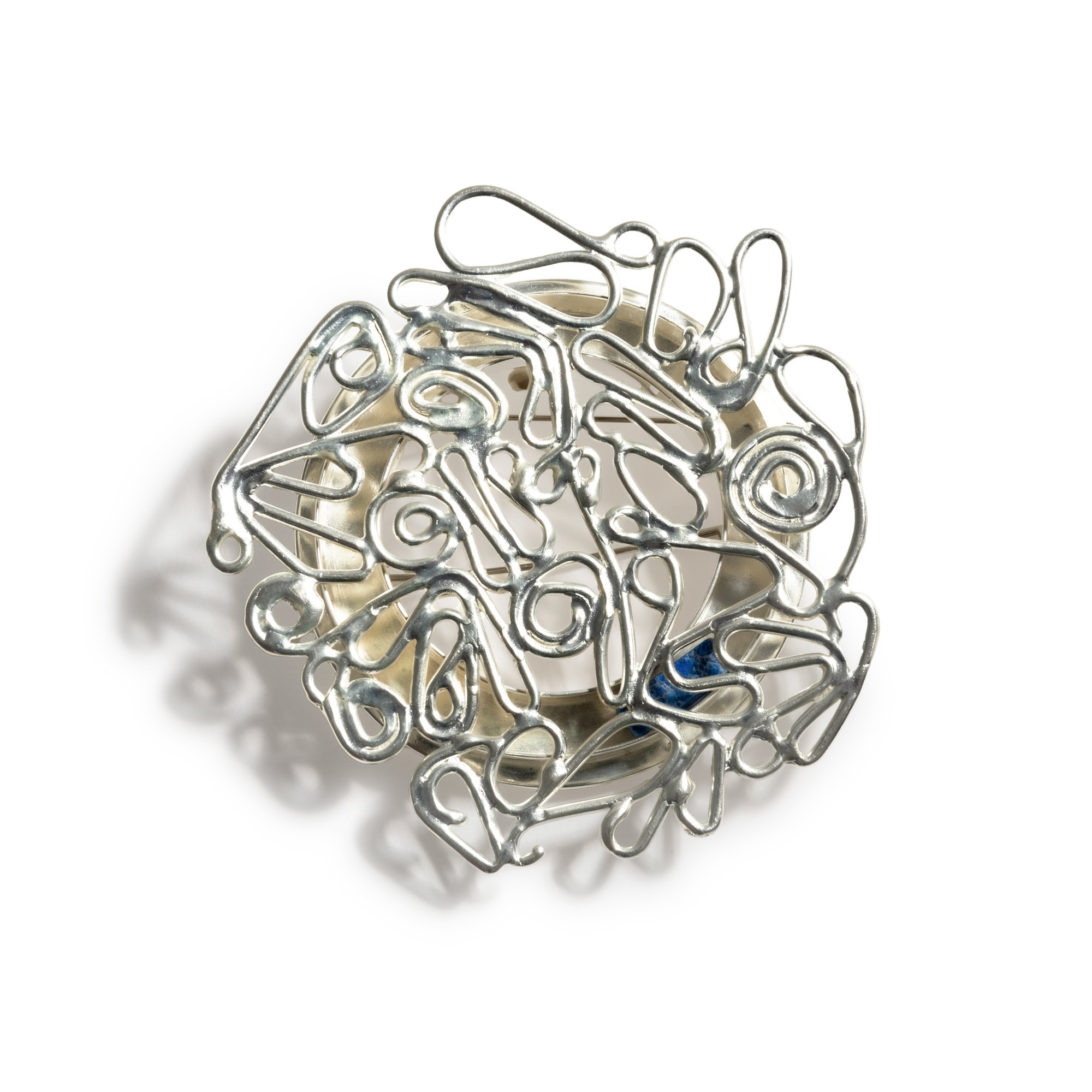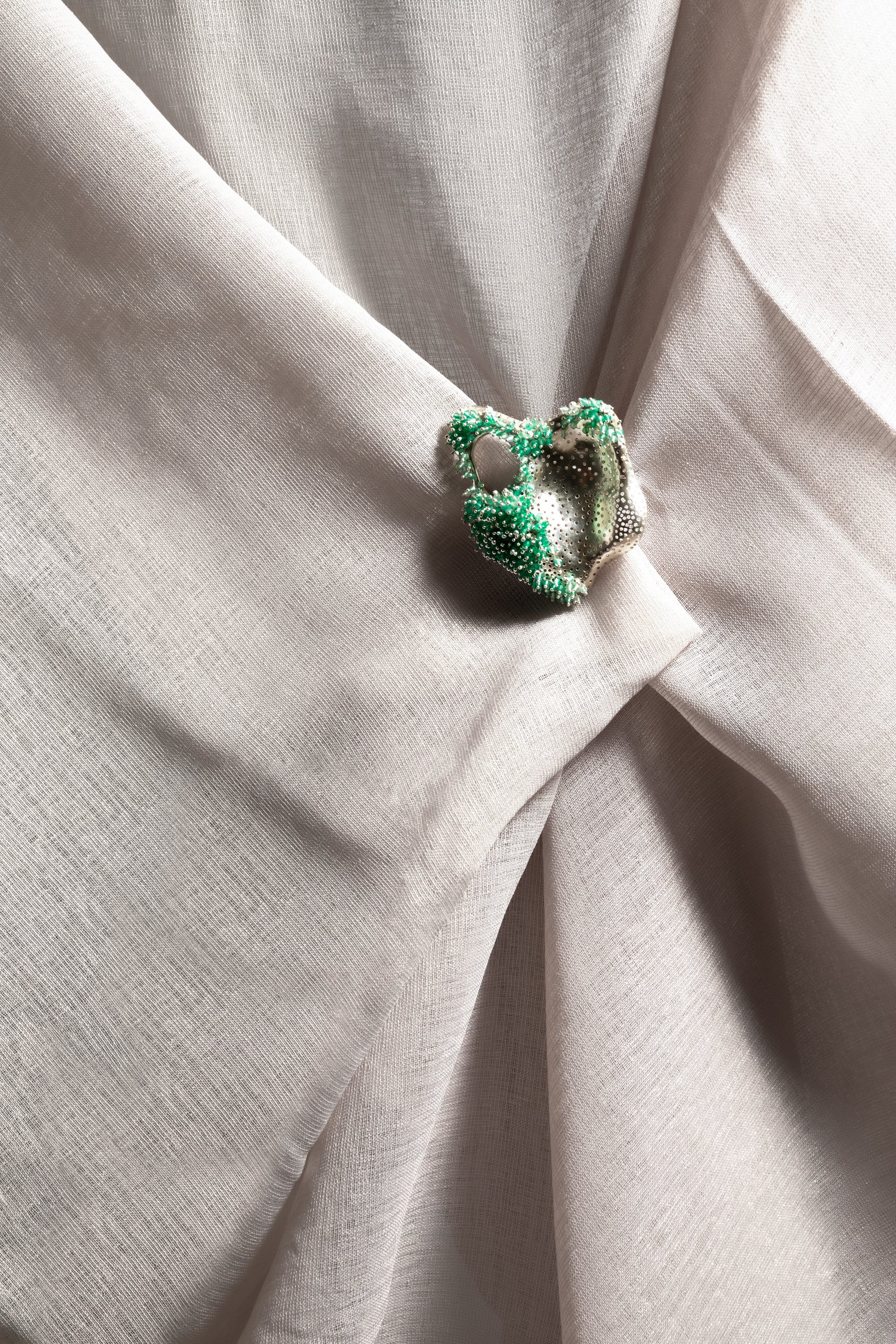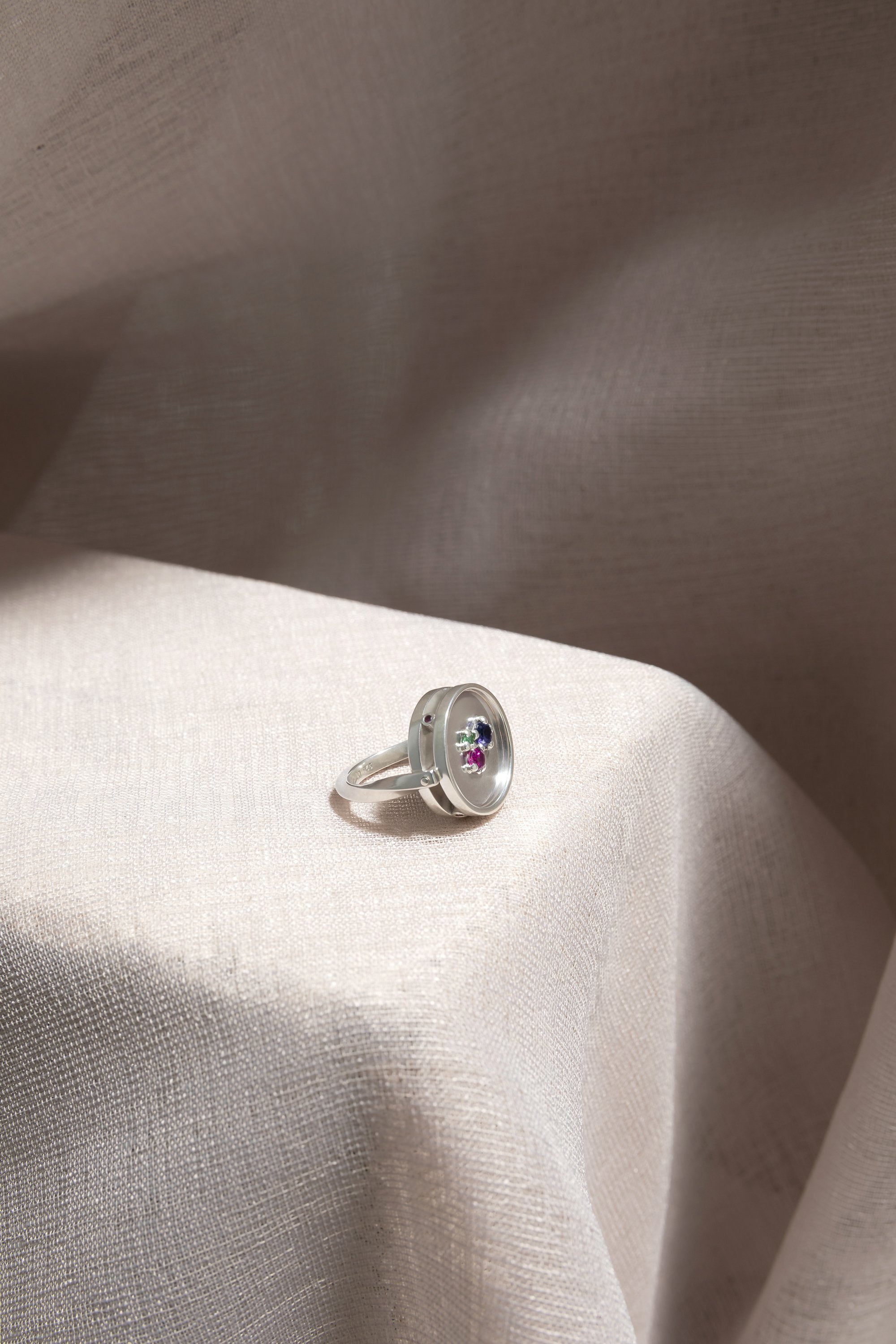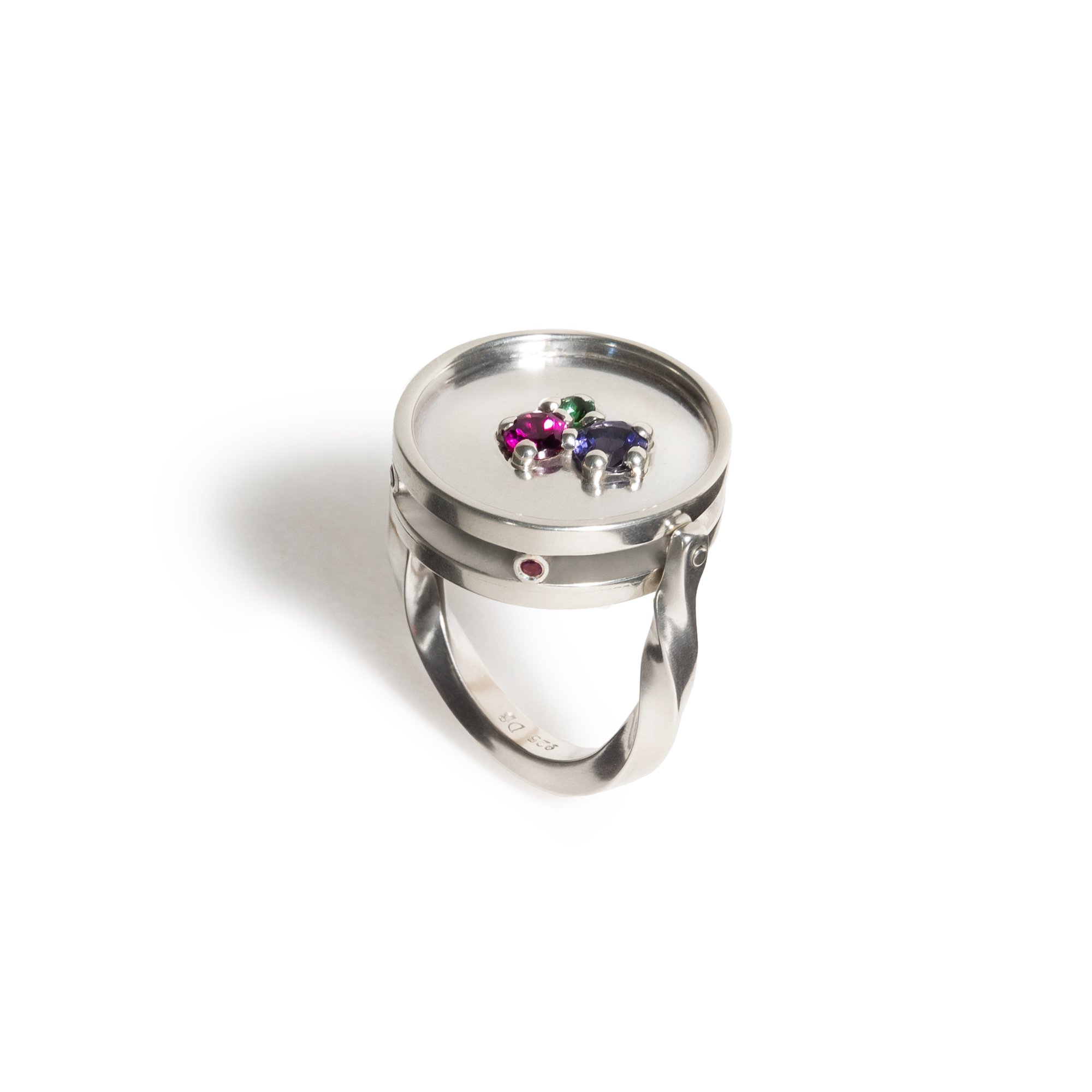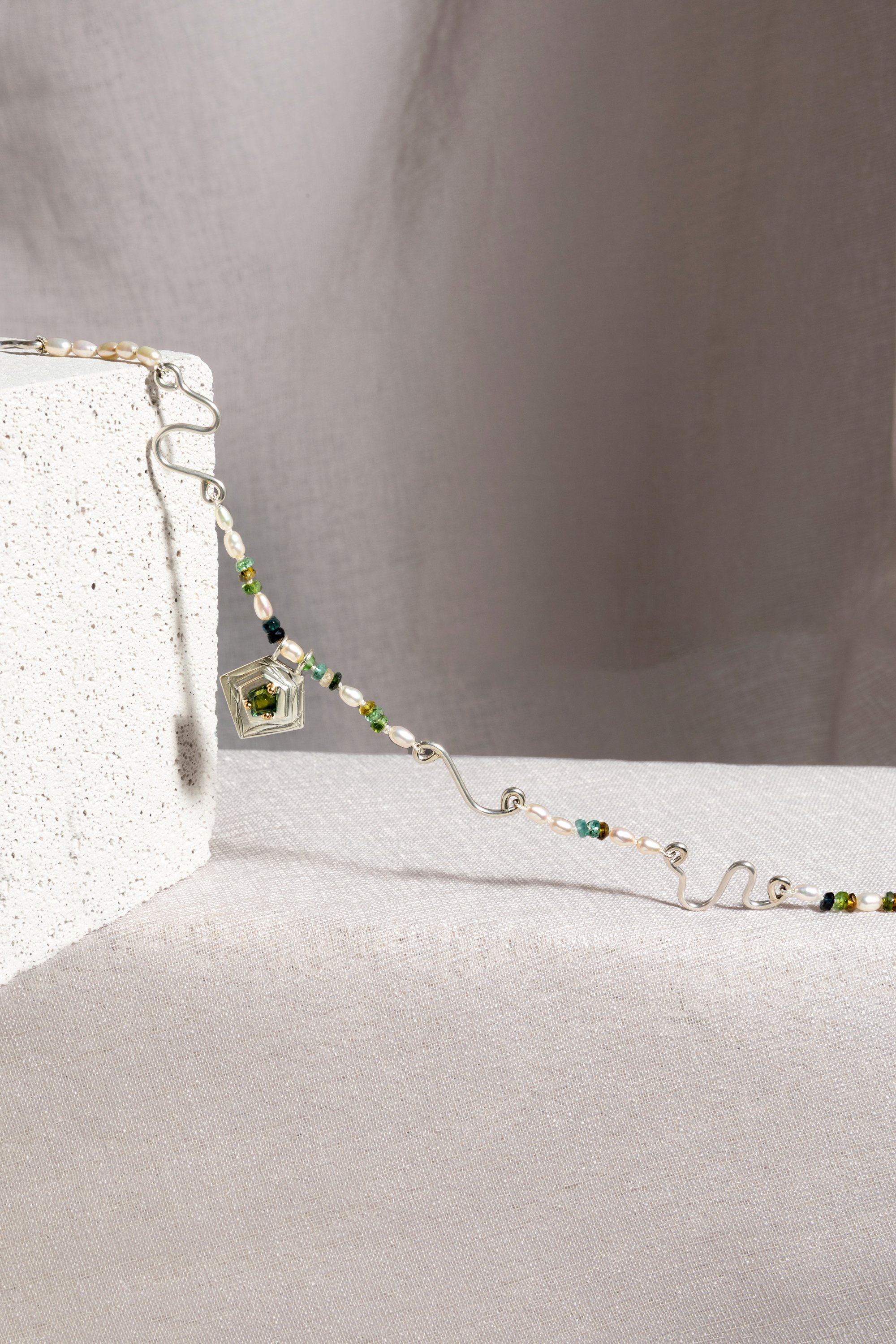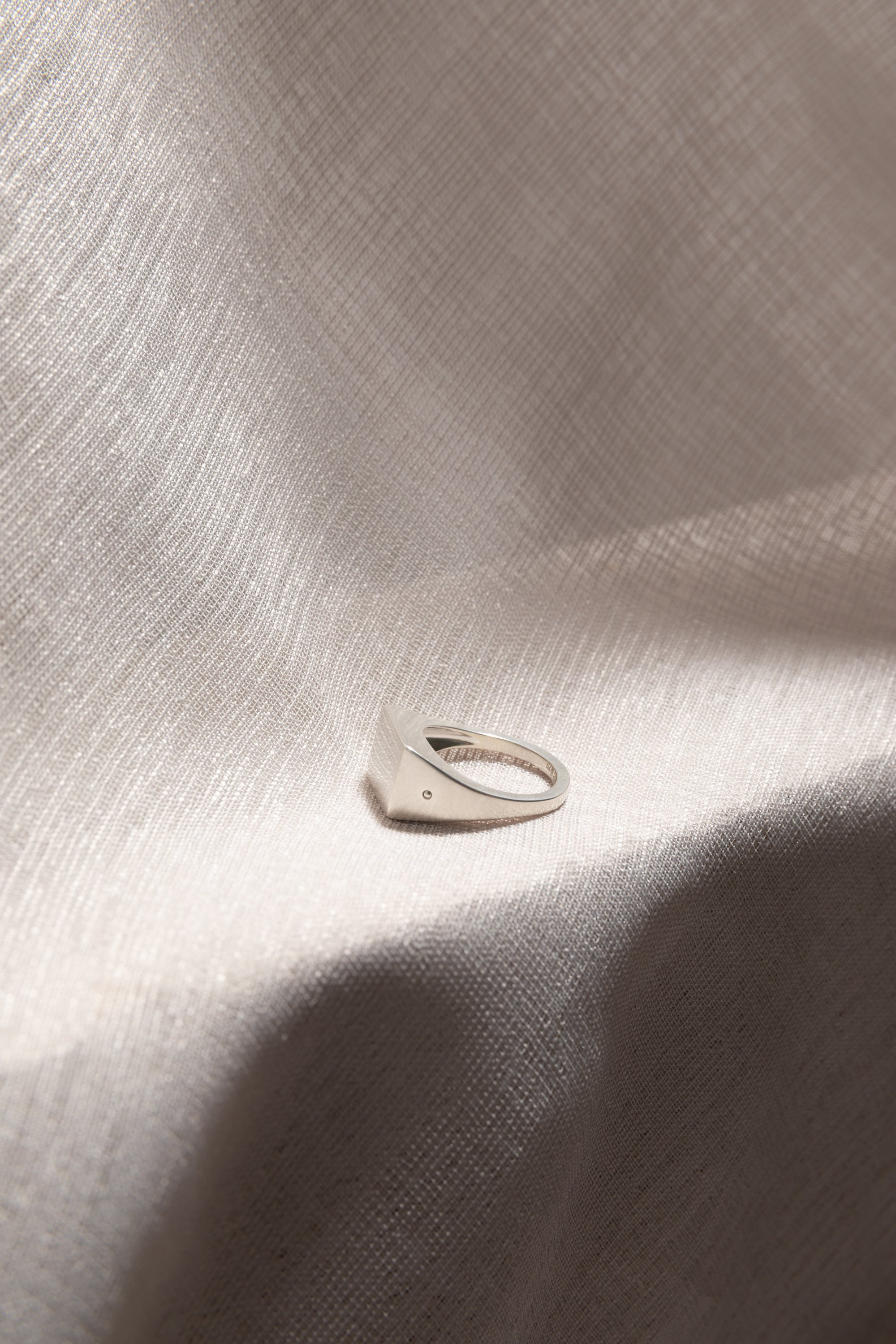Deviate
Exhibition: Kin Gallery, Canberra, ACT
11/11/2023 - 18/11/2023
Imagery by Karina Sharpe of Image Up Club
Filming, editing and video work by Connor Patterson
With thanks to Arts South Australia for partially funding this project
Film by Conner Patterson
Deviate is a collection of jewellery that explores the lives and contribution of twelve noteworthy people of marginalized genders.
This idea first stirred from a desire to explore untold stories; those that are often ignored in history classes or unexplored in cinema or film. The idea churned and morphed into, at first, an annoyance at the focus in all popular culture on the same stories from people of similar backgrounds which reiterate old societal expectations, to a genuine desire to find stories about people who deviated from traditional and societal expectations.
The weaponized fragility, grit, passion and bravery these individuals experienced and required throughout their lives served as the inspiration behind each piece.
Danielle has used her own symbolic language of viewing precious metal as pages in a book that can be used to weave together the narrative elements of each person’s life into their jewellery piece, with the hope of creating pieces that are not only beautiful, but also convey substantial meaning.
These pieces are not intended to encapsulate an entire person; their being, their feelings and the meaning of their existence. But rather, Danielle has sought to make each piece as a gift to them; an ode to their contributions. If only one person who sees this collection learns about, and remembers, one of these undervalued and under praised people and the impact that their lives had on the world, then the collection has successfully achieved its celebratory intention for these thirteen noteworthy individuals.
For Jeanne De Clisson
French born noblewomen Jeanne de Clisson (née de Belleville) became one of the most successful pirates and privateers of all time.
After two unsuccessful marriages, Jeanne was happily married to Olivier IV de Clisson in 1330. Olivier and Jeanne controlled large territories in Poitou whilst having five children, three of whom survived their childhood. During this time in France, the war of Britton succession was underway (part of the 100 years war between the English and the French). Jeanne’s husband was a commander for the French King and was successful in many battles. Whilst trying to retain control of the French city, Vannes, Olivier and his men were captured by the English and imprisoned for many months. The two countries brokered a surprisingly low ransom and a prisoner’s exchange which saw Olivier returned to his family. Some of the French nobility suggested that he was released too easily and for too small a ransom considering Olivier’s noble birth. Rumours spread and the French court began to believe that Olivier was a traitor who deliberately lost battles to favour the English.
In 1343 the French and the English signed a truce and King Phillip VI held a tournament to mark the occasion, inviting French Lords and noblemen. During the festivities the King’s men arrested Olivier for treason. Olivier was taken to Paris tried and found guilty with record speed. With no public announcements or correct protocol, Olivier was beheaded. His decapitated head was displayed on a spike at the gates of Sauvetout; an act never committed to noblemen but reserved for commoners and thieves.
Jeanne had been trying to free her husband during this time but had neither the power nor the privilege of time as the King purposefully quickened the pace of the trial and execution.
This marked the turning point in Jeanne’s life. She travelled to Sauvetout with her two young sons to view Olivier’s decapitated head. There, she swore revenge upon the French, her own people and King Philip VI.
Jeanne quickly sold many De Clisson estates and possessions and used the money gained to raise a 400 strong force and began to wage war upon the French countryside. She started by raiding and attacking nearby castles and towns. Jeanne and her troops massacred entire divisions of soldiers, even those who fought for her husband when he was alive. She became known for leaving one soldier alive after each successful battle. That soldier would then spread the news about Jeanne’s wrath which caused fear among the French and was reported to the King.
At the age of 43 Jeanne met with King Edward of England and formed an alliance against the French King. With his financial assistance and her remaining troops, she bought three warships and outfitted them with provisions and soldiers. She painted the three ships black, dyed the sails red and named the flagship ‘My Vengeance’. From here she embarked upon a 13 year long career as a pirate and privateer, sailing the English channel and killing all personnel, bar-one, on both warships and French commerce ships alike.
As news of her terror spread, she was given the moniker the ‘Lioness of Brittany’ as she was rumoured to have the heart of a lion’ and the soldiers of her ‘Black Fleet’ swore undying loyalty to her as their captain and leader. French sailors became genuinely terrified of Jeanne and her privateers as only one person ever survived each attack.
Whenever she boarded and captured a ship all supplies and goods were given to the English to assist them in their battles against the French. In 1350 when the French King, King Philip VI, died her anger did not fade but instead strengthened. She began specifically targeting and attacking ships with French noblemen aboard. She would behead them herself once their ships were captured.
Jeanne remarried an English nobleman named Sir Walter Bentley at age 57. They both had fought the French and jointly decided to retire to the English countryside were Jeanne died of natural caused at age 59.
For Artemisia Gentileschi
1593-1653
(Trigger Warning – assault)
Artemisia Gentileschi was an accomplished Italian Baroque painter and was also one of the first victims in documented sexual assault case who technically succeeded over her attacker.
Born in Rome, Artemisisa was the daughter of Orazio Gentileschi, a painter enamoured by Caravaggio and the Baroque painters of the time who were proponents of dramatic realism. Artemisia led quite a secluded life; she mostly stayed in her home in Rome as the streets were not safe for a girl of her age and standing. From sketches she made as a child her father and his artistic friends could see Artemisia had talent and she soon became a pupil of her father and Agostino Tassi, a friend of her father’s who specialized in landscape painting. Even during her formative years, she painted large portraits and biblical scenes that are still studied as examples of excellence for the genre today. She is said to have produced painting of professional standard by the age of fifteen.
While being left alone with an older man would have been improper for a woman at that time, since Tassi was a trusted friend and tutor, this did happen on occasion. On one of these occasions Tassi sexually assaulted Artemisisa in her own home. When her father learned of the assault, he insisted Tassi marry Artemisia as she had been ‘ruined’ for future betrothal. When Tassi refused, her father bought Agostino Tassi to trial in 1612; not for the assault of his daughter, but for violating the family’s honour. During the trial it was revealed that Tassi had plans to murder his wife, had committed adultery and had planned to steal Orazio’s paintings.
In court, Artemisia was tortured with thumbscrews for the purpose of verifying her testimony. At the end of the trial, Tassi was exiled from Rome, although the sentence was never carried out. At no point was he tortured to garner a truthful testimony.
After the trial Artemisia married and became the first woman to join Florence’s Academy of Design. She began to specialise in historic paintings and was associated with the Medici Court, who financially supported her to create a series of frescoes honouring the life of Michelangelo in the Casa Buonarotti. In 1638 she arrived in London, where she worked alongside her father for King Charles I. They collaborated on the ceiling paintings of the Great Hall in the Queen’s House in Greenwitch.
Scholars now view her as one of the most progressive and expressive painters of her generation, with the recognition of her talents exemplified by major exhibitions, and retained in major collections.
For Truus and Freddie Oversteegan
1925-2018 and 1923-2016
Freddie and Truus were born in Haarlem in the Netherlends to their single working-class mother. They grew up in relative poverty, lived on a barge and joined the Dutch resistance during World War 2 at ages 14 and 12.
With their mother, they handed out anti-Nazi pamphlets and newspapers and would glue them over Nazi propaganda and then ride off on their bicycles. Both girls looked young, even for their youthful ages, and began to see how their gender and their supposed innocence could work in their favour against the Nazis. After being recruited by the commander of the Haarlem Resistance Group in 1941 the sisters’ missions became more serious; sabotaging railway lines and bridges and learning to shoot the enemy soldiers.
Freddie would consciously wear braids to appear younger and both her and Truus would seduce SS officers and lead them to the woods to be killed by other members of the resistance. Soon the two sisters began to go on assassination missions themselves, focusing on finding and killing high ranking Nazi officers and Dutch collaborators. Between hiding Jewish refugees, working in emergency hospitals and blowing up bridges, they met Hannie Schaft another young female resistor. The three women became inseparable and formed a sabotage and assassination trio that saw them risking their lives daily. They would seek out soldiers at bars and engage them in conversation to find out classified information and hierarchies within the organization. They would often ride up to Nazi soldiers on their bicycles, shoot them in the street and ride off, often going unnoticed. Hannie was executed three weeks before the war ended, while both Oversteegan sisters lived until the age of 92.
For Noor Inayat Khan
1914-1944
Noor Inayat Khan was a British spy who served in the Second World War. She was the first female wireless operator to be dropped onto occupied France.
Noor was the eldest of four siblings born to an American mother and Indian father, who later became the head of the Sufi Order in the West. Her father was a musician and much of their childhood was led my Sufi spiritual practice. Noor was said to be a shy and ‘dreamy’ young girl but became the head of her household when her father died, and her mother was house-bound with grief. When the second World War broke out the family moved from France to England, where both Noor and her brother decided they wanted to fight against the Nazis, despite their pacifist religious upbringing. Noor was quoted saying she specifically wanted to be of service as she felt that “if some Indian would win high military distinction in this war… it would help to make a bridge between English people and the Indians”.
In 1940 Noor joined the Women’s Auxiliary Force and trained as a wireless operator in occupied territory. Her training was not overly successful; during fitness and security training her training officers did not believe she would be suitable to work in the field. They referred to her as ‘childlike’ and having too gentle a manner, clumsy, emotional and kind-hearted, and someone who tended to give away too much information. However, her wireless tapping skills were among the fastest in her class and she was judged to be ready for war.
The task was to keep messages flowing between London and the resistance officers in France in relation to sabotage operations and weaponry; without this communication no resistance could be coordinated. The work was difficult as transmitters could only be on air for less than 20 minutes or they would be detected by the German soldiers, their transmitters were bulky and needed to be carried in suitcases which would be unexplainable should they be captured. The life expectancy of these workers was six weeks at the time. Under the code-name Madeline, Noor transmitted messages in occupied France to London for almost four months when Noor was betrayed by the sister of a fellow agent.
She was imprisoned and questioned at the Gestapo Headquarters and attempted to escape twice but was unsuccessful. As she gave no information and refused to sign any declarations, she was considered a particularly dangerous and uncooperative prisoner. She was sent to the Dachau Concentration Camp where she was killed. Her last words were said to be “Liberte”.
For Juliane Koepcke
1954-present
Juliane Koepcke was born to German zoologists Maria and Hans-Wilhelm Koepcke who specialised in neotropical bird species and South American fauna respectively. She was born in Lima and left with her parents at the age of 14 to establish Panguana, a research station in the Amazon rainforest.
In 1971 at 17 years old Juliane and her mother were planning to fly to Pucallpa from Lima on LANSA Flight 508, despite her father urging them both to avoid this airline due to its poor reputation.
While flying over the Amazon rainforest the plane was struck by lightning and broke irreparably. Koepcke was still strapped to her seat and fell from 3000m height into the rainforest, surviving the fall with only a broken collarbone, a deep cut on her arm, an eye injury and a concussion.
She looked for other survivors and other traces of life, most especially her mother, but found none. After finding a bag of lollies, she decided she needed to follow a nearby creek which would lead to rivers, which would eventually lead to civilisation. Due to exhaustion, she knew she wouldn’t make it on foot and as she had terrible eye-sight due to losing her glasses in the plane crash and sustaining an eye injury. She made the decision to lie in the river and let the water currents carry her down-stream. Having grown up at Panguana with zoologist parents Koepcke knew a few things that would make a survival of 11 days possible. She knew that the crocodiles would generally be unbothered by her presence and that she needed to float mid-stream, as her father had told her that piranhas were only found in the shallows. She knew that when she walked in the water, she needed to drag her feet so as not to lift them and step on the many stingray barbs that she knew could fatally wound her. As it was the wet season it rained hard and often, so it was too damp to light a fire. She knew much of what grew in the forest was poisonous and no trees bore edible fruit at that time. In the evening she would walk to the riverbank and huddle under large foliage to try and keep out of the rain and attempt to get some rest.
On her ninth day alone in the jungle Juliane noticed a small palm-leafed hut. She made her way inside and poured some petrol from a can that she found on her arm wound which had become infested with maggots. She spent the night in the hut and was woken by the sound of men’s voices. She explained who she was and they helped her get to safety.
After returning to Germany after recovering from her injuries Juliane studied biology and eventually became a research mammologist who specialises in the study of bat colonies in Peru’s rainforests.
For Masako Katsura
1913 – 1995
Masako Katsura is known as ‘the First Lady of Billiards’ as she was the first woman to compete in an international billiards tournament.
Katsura was born in Tokyo, and at age 12 she went to live with her older sister and her husband after her parents died. Her brother in law owned a billiards parlor, so Katsura spent two years playing the game daily and at age 14 became a billiards attendant. She began competing against the men who would come into the parlor and soundly beat them all. At 15 she won the women’s championship straight rail tournament in Japan, even inspiring her two younger sisters to earn the same title years later.
Before the outbreak of World War II Katsura had met Kinrey Matsuyama, a Japanese billiards champion who helped train Katsura to become the only female professional player in Japan.
After the war Katsura met a USA Army master sergeant who had been interested in Katsura after watching her play a billiard exhibition, and asked her to give him lessons. They soon fell in love and married in 1950 whilst she simultaneously set billiards records and placed second in Japan, twice.
In 1951 Katsura’s husband was transferred back to San Francisco. Katsura spoke little English and after the War and Pearl Harbour bombing, Japanese people were largely unwelcome in the USA.
Despite this ill-feeling Katsura was invited to play at the 1952 World Three-Cushion Billiards and was the first woman to compete for any world billiards title. Much was made of Katsura appearance in the media remarking at her small and doll-like appearance and grace in a sport that had mostly been played by men. While Katsura only took out second place, this was a huge achievement and launched an exhibition tour with 8-time world champion Welker Cochran. While the organizers of the tour exaggerated Katsura’s physical features and even had Katsura wear a tight-fitting kimono during the exhibition Katsura performed well and was a huge sensation to the public. She continued to play exhibition matches and appeared on American television, but after the 1961 World Championship seemed to disappear off the billiards circuit. Much of this was attributed to the death of Matsuyama, Katsura’s first mentor.
For Nzinga
1583-1663
Nzinga Mbande was a Southwestern ruler of the Ndongo and Matamba people (present day Northern Angola). Nzinga was born to the King Ngola Kiluanji and his favourite concubine Kengela Ka Nkombe. In Mbundu her name is an alternative spelling for the word ‘to twist’, and she was so named as she was born with her mother’s umbilical cord wrapped around her neck. In royal blood lines those who survived difficult or unusual births were believed to have spiritual abilities, and this was an indication of future power.
The King favoured Nzinga above his many children. As a female child she was not considered a likely heir and therefore not a threat to her male family members, thus this favouring was not looked upon with suspicion. Nzinga received training as a warrior and fought alongside her father and become known for her skill in battle, most specially her use of a traditional Ndongan battle axe. Besides warfare, Nzinga was also allowed to participate and witness governance with her father including war and legal councils as well as ritual ceremonies and practices. Additionally, Nzinga was one of the few leaders who availed herself to the Portuguese missionaries who taught her to read and write in Portuguese.
In this part of Africa at the time, the kingdom of Ndongo faced much upheaval. Other African territories were often attempting to take land and both the Portuguese and the Dutch were attempting to gain land and enslaved people in this region. Most pressingly, the Portuguese established an alliance with the Kingdom of Kongo, known in particular for their rivalry in Ndongo and their strength in battle. The Portuguese were attempting to set up a trading post in Luanda and initially their relations with the Ndongo peoples was peaceful. However the relationship soured and initiated decades of war between the two nations. Additionally in 1607, a tribal warrior group called the Imbangala invaded Ndongo. Members of this group were hired by the Portuguese as mercenaries since they were known for being particularly fierce and violent and were used to force the Ndongans to give up territories.
Upon King Kiluangi’s death in 1617 Nzinga’s brother Ngola Mgandi ascended to the throne. His first months of leadership involved vicious attacks on all male members of his family, killing his brothers, Uncles and Nzinga’s only son so there would be no other claim to his throne. Simultaneously his war against the Portuguese was not as successful as that of his father’s reign and the Portuguese gained territory. In 1621, realising he was unable to lead on his own he asked Nzinga to act as an envoy to the Portuguese in Luanda. Fluency in Portugese and the royal bloodline compelled her standing in this rank and she gained enough interest to induce the Portuguese governor to meet with her.
Ndongan people typically met European leaders in European dress, but on this occasion Nzinga chose to wear traditional clothing of the Ndongan people. A tactic often employed by the Portuguese was to sit on a throne when meeting African leaders and gesturing for them to sit on the floor to drive home their ‘subordinate’ or conquered status. Upon this reception, Nzinga motioned to one of her subordinates who knelt on his hands and knees, forming himself into a chair. Nzinga sat on his back for the entire meeting and negotiated terms with the Portuguese, including paid tribute from the Portuguese, peace in the region and Nzinga agreeing to be publicly baptized into Catholic faith. This peace treaty was signed in 1622. Upon the Imbangala gaining Ndongo territory the King became less respected, and the Portuguese were showing signs of defecting on the treaty. King Mbandi is said to have fallen into a deep depression and died from either suicide or poisoning in 1624.
Nzinga succeeded him though she faced much opposition from male lines in other noble families. It was argued that her willingness to broker deals with the Portuguese showed weakness and being born to the ‘slave wife’ of the prior King, not the ‘first wife’, weakened her bloodline. This was all used to discredit her position, in addition to the Mbundu people not encouraging female leadership. To gain support Nzinga, rallied soldiers from a small band of the Imbangala warriors who were not allied with the Mbundu or the Portuguese. She also offered positions for the enslaved people who had escaped Portuguese territories. This increased Nzinga’s domestic political efforts as Imbangala’s differing hierarchical structure did recognise female leaders of battle and political pursuits.
By 1631 Nzinga’s army was battling successfully against the Portuguese and gaining territory. She invaded the Kingdom of Matamba, deposing the sitting queen Mwongo Matamba, but sparing her life (Imbangala custom was to execute the defeated leader) and taking the defeated Queen’s daughter on as a warrior. Now reigning over Matamba, which had a history of accepting female leadership, Nzinga settled the Ndongo people in Matamba.
Once her troops invaded new territories, the captives could be sold as slaves. It is thought that nearly 200,000 slaves were sold to both the Portuguese and the Dutch, funding much of Nzinga’s leadership campaign. While this was common practice at the time, history now looks upon these actions unfavourably.
The struggle between Nzinga and the Portuguese to limit land acquisition and dominance over the slave trade was strengthened when Nzinga and the Dutch agreed to form an alliance. For some years Nzinga gained control over her Ndongo lands, though Portuguese invasion did eventually make her retreat to Matamba.
After 25 years of war, Nzinga’s Kingdoms and Portugal agreed upon terms of peace in 1657 when Nzinga was 74. Nzinga’s final years in her 30 year campaign as Queen also saw her establish contact with Christian leaders, even having exchanged letters with the Pope. She believed having Matamba internationally recognized as a Christian Kingdom would provide stability to her land and assist her sister Kambu to ascend the throne after her death.
While bloodthirsty and fairly criticized for her pivotal role in the slave trade, Nzinga is notable in gender studies as during her leadership she was known to wear traditionally masculine clothing and use masculine titles. She had female as well as male concubines who she ordered to wear female dress and was addressed as King rather than Queen. It is said that whilst fighting with the Imbangala, Nzinga performed a ritual ceremony which cemented her identity from Queen to King.
For Bessie Stringfield
1911 – 1993
Bessie Stringfield is known for being the first solo female African American to ride a motorcycle across the United States.
Born in Jamaica, Bessie’s family migrated to Boston where Bessie’s parents both died of smallpox. She was adopted by an Irish woman who raised Bessie to be catholic and while she did not believe that woman should ride motorcycles gifted her adoptive daughter a motorcycle for her sixteenth birthday after many years of Bessie pleading for one.
From the 1930s to early 1940s, Bessie made eight long distance solo rides across the US. She would perform motorcycle stunts at carnival shows to earn money and would enter riding competitions. Prejudice against mostly her race and her gender made certain aspects difficult. She was denied accommodation, leaving her to sleep on her motorcycle as petrol stations. In competitions she would often be excluded due to her gender so would often give a fake male name and not take her helmet off until the prizes were handed out. Even still, upon winning and taking her helmet off to reveal she was female, the prize money was withheld.
During the Second World War, eager to be put to use Bessie worked as a civilian motorcycle dispatch rider for the US Army. She was the only female in the unit and executed difficult training procedures, many at a higher standard than her male counterparts.
In the early 1950’s Stringfield settled in Miami Florida and became a licenced nurse. She continued to ride and founded the Iron House Motorcyle Club and was known as the ‘The Motorcycle Queen of Miami.’
Known for owning 27 Harleys in her lifetime, cruising around Miami with her dogs nestled next to her, 6 marriages all ending in divorce and refusing doctors orders to give up riding due to an enlarged heart condition Bessie broke gender and racial barriers and was inducted into the Motorcycle Hall of Fame in 2002.
For Wangari Maathai
1940-2011
Wangari Maathai was an environmentalist, teacher, woman’s rights activist and political activist who founded the Green Belt Movement.
Maathai was born in 1940 in rural Nyeri, Kenya. Maathai was awarded a scholarship that saw 300 Kenyans to study in America through a program funded by John F Kennedy who was a United States senator at the time. She used this scholarship to study Biological Sciences in America and received her Masters of Science degree from the University of Pittsburgh. It was during her studies in Pittsburg that she witnessed environmental activism first hand when she saw how local environmentalists were fighting to rid the city of air pollution.
She had been offered a position as a research assistant to the Professor of Zoology at the University College of Nairobi after completing her studies in Pittsburg. When she moved back to her home land, she was told the job had been given to someone else. Maathai believed this was due to a bias toward her gender and tribal group. After receiving another position from a German professor in Veterinary Anatomy, this professor encouraged her to pursue her doctorate overseas. She travelled to Germany and studied at both the University of Giessen and Munich.
After returning to Nairobi as an Assistant Lecturer in 1969 Maathai married Mwangi Mathai who was a politician. They had two children together and Maathai continued to teach at Nairobi as a Senior Lecturer in anatomy, Chair the Department of Veterinary Anatomy and became an Associate Professor. She was not only the first woman in Nairobi to be appointed to any of these positions but also campaigned for equal benefits for university staff during this time. While her bid to form a union was denied many of the female staff’s other demands were met.
Maathai became involved in a number of organizations such as the Kenya Red Cross Society, the Environment Liason Centre and the National Council of Women in Kenya. It was this work that made it evident to her that many of the problems Kenya was facing; work and food shortages, water sanitation and landslides, were all due to environmental damage.
After having her third son and her husband obtaining a seat in Parliament Maathai proved useful in his campaign. Her husband had promised to deal with rising unemployment in Kenya which connected to Maathai’s idea of conserving the environment by planting trees. This led to her founding of Envirocare Ltd. which did fail due to a lack of funding but paved the way to the Green Belt Movement being established.
The Greenbelt Movement started simply with Maathai using her platform to encourage women of Kenya to plant native trees throughout the country. Each woman was paid a stipend for each planted seedling. This organization grew in the oncoming years with help from the Norwegian Forest Society which led to hiring additional employees and to continue paying women across Kenya to plant seeds.
The UN held its third women’s conference in Nairobi where Maathai arranged lecturers to describe the Movements’ work. Delegates who were given tours of the nurseries of trees that the Movement planted and were pivotal in expanding the movement to the foundation of the Pan-African Green Belt Network. Representatives from 45 African countries travelled to Maathai to learn how to set up their own organisations that tackled the same issues with desertification, water crises and rural hunger due to deforestation.
In 1988 the Maathai’s Green Belt Movement carried out pro-democracy activities such as encouraging people to vote. The Kenyan government sought to silence Maathai by prohibiting the Movement to meet. A 60 storey building was set to be built in Uhuru Park featuring shopping malls, offices, car parks and trading centers. Maathai protested this by writing letters to the Presidential office, city commissions and newspapers.
The government refused her objections and began to smear her name through the media, often referring to her divorce from her husband and even the president remarking in a speech that Maathai should act like a ‘proper’ African woman, ‘respect men and be quiet.’ The government forced Maathai and the Movement out of their offices and audited them in attempts to shut them down. Maathai moved the movement to her home.
Two years later Maathai received word that herself and other pro-democracy activities were assassination targets and that a government sponsored coup may be possible. Maathai’s house was surrounded by police officers later that day and after three days of being trapped the police were able to cut through her barricaded windows and arrested her. Maathai and other pro-democracy activists were arrested for spreading malicious rumours, sedition and treason. She was released on bail and American senators such as Al Gor and other international organisations successfully pressured the Kenyan government to drop the charges against Maathai.
Maathai continued to push for democracy for many years even with pressure being put upon her by the government. When a public land in the Karuru Forest was set to be privatized Maathai and the Greenbelt movement marched upon the area with journalists and local MP’s. The entry to the forest was guarded and when Maathai went to plant a tree the group of protestors were attacked.
Maathai, four MP’s and some journalists were injured which sparked international as well as national outrage. Protests broke out across Nairobi leading to the President announcing that the land would remain public.
After leaving Kenya to teach at Yale University’s School of Forestry and Environmental Studies Maathai returned to Kenya and campaigned for parliament as a candidate in the National Rainbow Coalition. In 2002 this party defeated the Kenyan African National Union and Maathai was appointed as the Assistant Minister in the Ministry for Environment and Natural Resources in 2003 to 2005. It was in 2004 that Maathai won the Nobel Peace Prize for her ‘contribution to sustainable development, democracy and Peace’ which also made her the first African Woman to win the award.
For Josefina Guerrero
1917-1996
Guerrero was a Philippian woman who used her diagnosed leprosy as an asset that allowed her to act as a spy in World War II.
Born in Quezon, Guerrero was raised by her grandparents after her parents died when she was a child. She was happily married to a promising medical student when she was sixteen years old and they both had a daughter two years later. In 1941 Guerrero contracted Hansen’s disease known as Leprosy which, while now can be easily managed, was a feared diagnosis that led to being ostracized from your community due to the fear of the disease spreading. During this time people with the diagnosis were often made to wear bells and announce themselves if they were in public spaces.
Guerrero was separated from her husband and child and while she was able to keep noticeable effects of the disease unseen with a topical treatment when Japan occupied the Philippines in 1942, her access to her medication was cut off. Finding herself grappling with the disease she fell into a depression realising she would most certainly have a painful death without the medication, and realised if she were to die she wanted it to be a purposeful death. She contact the Philippine guerrillas who were operating in Manila and became a spy, working to courier/deliver messages about plans and troop movements to the Allied Forces.
While other Philippinos were stopped and searched, due her disease Japanese soldiers would not come close to her once they saw her lesions and declared her ‘unclean’. This allowed her to successfully courier messages, weapons and supplies to resisting soldiers, often hiding messages and parcels between her shoulder blades, in her hair and between pairs of socks.
As war escalated Guerrero became more integral to the resistance, she was responsible for mapping out Japanese fortification and gun emplacements. This map was used to defeat the Japanese defences in the Manila Harbor and take back the waterfront. Her most known and dangerous task was carrying a map of minefields around Manila to American soldiers 35 miles North of Manila. This would allow the Americans to get to Manila unharmed to end the three-year occupation of the Philippines. Boating, walking and traversing active battles grounds, outrunning river pirates and battling the fatigue and headaches caused by her disease, she managed the trip and handed the map directly to the Captain. The Americans safely got to Manila and entered into a month long battle with the Japanese. During this battle Guerrero’s tended to the wounded, carried children to safety and read rites to the dying.
After the war, despite her invaluable contribution to the war effort she was sent to a Leprosarium. Without running water and electricity, with 4 nurses to the 650 patients and without proper bedding, clothing and food many deaths were caused by unclean surrounds and malnutrition.
Undeterred, Guerrero built coffins for those who had succumbed to illness, cleaned the camp to the best of her ability and wrote a letter to a friend in San Francisco. This letter passed through many hands and eventually was used in a large expose written by the Manila Times. Other media outlets caught on and wrote about the conditions, which urged the government to investigate and rectify the situation.
Finally feeling hopeful about her disease Guerrero fought to obtain the first American visa for a foreign national with Hansen’s disease to make her way to the National Leprosarium in Louisiana which was at the forefront of Leprosy treatment. After nine years of treatment, her condition was finally put into remission.
Her long awaited freedom into a normal free life was not as she had hoped. She struggled to gain work, when her employers found out about her stay at the Leprosarium she was often let go. With the help of military personel, she was granted permanent residency in the United States, having lived there for nearly 20 years. To overcome the discrimination of her past disease she changed her name and tried to eradicate her past. She received two degrees and served in the Peace Corps. She met her adult daughter only once and those who knew her in America had no idea of her past as a war hero or her life in the Philippines. She lived out the rest of her life in America, remarrying and out of touch with anyone from her past life.
Aboriginal and Torres Strait Islander people should be aware that this web entry contains names and history of deceased persons.
For Oodgeroo Noonuccal
1920 -1993
Oodgeroo Noonuccal was an environmentalist, activist, veteran, teacher and poet. She was also known by the name Kath Walker. Her father was a Quandamooka man from the Noonucaal Clan from the area around Stradbroke Island and Moreton Bay and her mother hailed from the Peewee clan from inland Australia. Noonuccal was born in Minjerribah, North Stradbroke Island in Queensland in 1920.
Oodgeroo left school and home at the age of 13 to work as a maid in Brisbane. After being rejected from nursing school due to being Aboriginal at the age of 21 Oodgeroo enlisted in the Australian Women’s Army Service after her two brothers were captured by the Japanese in Singapore.
After her military service, Oodgeroo joined the Communist Party of Australia and began her career as an activist through writing poetry, public speaking and politics. In 1963 she became Australia’s first published Aboriginal poet and she won multiple awards. Writing poetry, fiction, essays and speeches as well as as children’s books Oodgeroo questioned the treatment of Indigenous people and gave voice to feelings of displacement and discrimination.
She became a leading member of Indigenous Organisations and focused much of her energy on demanding constitutional change to end state and government control of her people. After reaching success politically and with her poetry Oodgeroo moved back to Stradbroke Island and established Noonuccal- Nughie Education and Cultural Centre at her home where she acted as an educator, cultural guardian and ambassador.
Aside from her work as a activist, poet and teacher Noonuccal was aboard the British Airways flight in 1970 when it was hijacked by Palistinian terrorists. Noonuccal and the other passengers were kept hostage for three days while the aircrew was forced to fly to various places in Africa. On the back of a motion sickness bag Oodgeroo wrote two poems.
She changed her name to Oodgeroo of the Noonuccal tribe in 1987 in protest to the Australian Bicentennial celebration. Oodgeroo referrers to the paperbark tree and Noonuccal is the name of her people. She had been awarded a MBE for her services to the community and in the same year she changed her name she returned her MBE to the Queensland Government in protest to the treatment of Indigenous people since white settlement.
James Barry
1789-1865
James Barry was a military surgeon for the British Army. He improved the conditions for wounded soldiers and also sought to treat the civilians in the places where war was rampant.
James Barry was born female at birth and known as Margaret Anne Bulkley. He lived as a male for the majority of his life and was only found to be biologically female in his post-mortem examination.
Barry was the second child to his parents and there is historical record of a third child named Juliana. It is widely speculated that this is Barry’s daughter as his post-mortem body was found to have stretch marks from pregnancy. Due to unsubstantiated reasons, perhaps Juliana being a result of Barry’s mother having an affair, or being Barry’s child both Barry and his mother left Ireland to gain financial help from Mary Anne brother James Barry who was a celebrated artist and painting professor at the London Royal Academy.
They were rejected by her brother while he was alive but inherited some wealth after his death in 1806.
The teenage Barry was very intellectually gifted and both his mother and his Uncle’s influential and creative friend group sought to make Barry’s dream of becoming a Doctor a possibility.
As women could not receive a medical education Margaret Bulkley ceased existing and James Barry arrived in Edinburgh for medical school at the University of Edinburgh.
Barry’s short stature, delicate facial features, lack of facial hair and unbroken voice caused those around him to suspect that he was a young boy who had not gone through puberty. This assertion caused the University Senate to attempt to block Barry’s final examination. The Earl of Buchan, a friend to Barry’s Uncle and namesake persuaded the Senate to allow Barry to become a qualified Doctor in 1812. In 1813 he successfully passed his examinations and became a qualified surgeon.
That same year Barry joined the army and was promoted to Assistant Surgeon to the forces within two years. Following military training Barry was sent to Cape Town in 1816. Having successfully treated Lieutenant General Lord Charles Somerset’s daughter back to full health upon arriving to South Africa, Barry was appointed Colonial Medical Inspector.
This huge jump in rank and responsibility allowed Barry to implement significant change over his ten years of work in Cape Town such as improving water and sanitation systems, improving conditions for enslaved peoples, prisoners and the mentally ill and providing provisions for a sanctuary for the leper population in the area. Barry is also known to have performed one of the first Caesarean sections where both the mother and child survived in history.
After being promoted to Surgeon to the Forces in 1827 Barry was posted to Mauritius, Jamaica, the island of Saint Helena, West Indies and Malta. In 1851 Barry was posted to Corfu and promoted to Deputy Inspector – General of Hospitals. This position allowed him to fight for better food, sanitation and adequate medical care not only for soldiers and their families but also for prisoners and lepers.
While known for his humanitarian work and his kind bed-side manner as a doctor he was also known for being violently tempered, heavy-handed and tactless in his demands which incited anger from military officials and officers thus Barry had been arrested and demoted often in his career for his behavior. Military records detail events where Barry clashed with fellow surgeons and was known for getting into an argument with Florence Nightingale during the Crimean War about unsanitary conditions.
Despite protesting the decision Barry was forced to retire by the army in 1859 due to ill health and old age. While he had been clear that upon his death he should be buried in his ‘bed sheets without further inspection.’ his body was identified as female when he died of dysentery in 1865.

